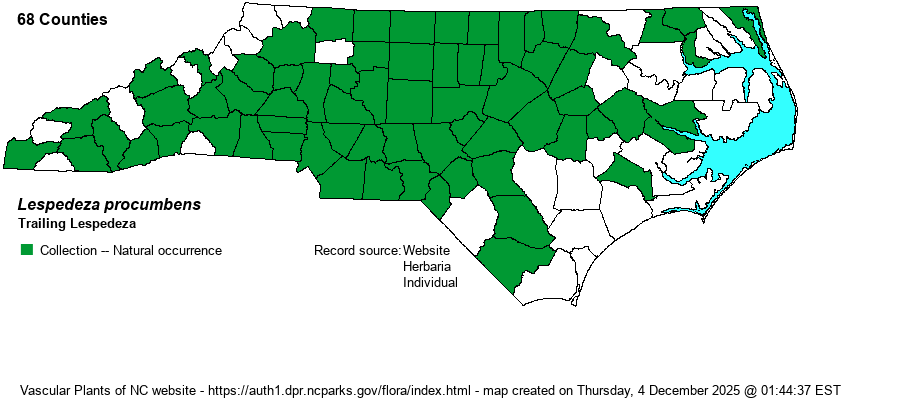| Author | Michaux | |
| Distribution | Nearly throughout the state, but of spotty occurrence in the lower Coastal Plain (where truly absent in a few counties) and in the northern Mountains. Owing to the difficulty of separating this species from the very similar L. repens from photos, reports from iNaturalist, even of Research Grade, are not added to the map.
This is a widespread Eastern species, found in most counties within its range from NH and southeastern KS south to northern FL and central TX. | |
| Abundance | Common across the Piedmont; infrequent to fairly common in the southern Mountains, but scarce in the northern Mountains. Infrequent in the northern and western Coastal Plain, but generally rare to uncommon in the southern half of the Coastal Plain, including the Sandhills region. | |
| Habitat | This species and L. repens are very similar in appearance, habits, and habitats, as well as range. Both occur in dry to (less often) mesic soil of woodland borders and edges, or in openings within woods. They tend to favor at least some shade, and are not numerous in wide open places like powerline clearings or overgrown fields. Habitat distinctions between these two do not seem to have been described, at least in NC. | |
| Phenology | Blooms from July to September, and fruits from August to November. | |
| Identification | Each of these two species -- L. procumbens and L. repens -- are very similar to each other and quite different from any other native Lespedeza species. Each typically has several trailing stems from a single base, growing along the ground to about 2 feet long. This species has the stem, flowering stalks, undersides of the leaflets, and the fruits quite densely hairy, with spreading hairs; the latter species is mostly smooth or at least has appressed hairs. The leaves have short petioles, and the 3 leaflets are quite small, each being elliptical with a rounded apex, only about 3/5-inch long and less than 1/2-inch wide. However, the flowering stems, coming off some of the leaf axils, have quite long stalks and generally are erect or leaning, growing to about 3 inches long, with perhaps a dozen small purplish flowers growing near the top of the stalk. Galactia species are also trailing and have three rounded leaflets, but their leaflets tend to be larger, brighter green and often shiny, and the flowers are usually close to the stem. Both Lespedeza species are commonly seen in the Piedmont, whereas the latter (L. repens) is also quite frequently seen in the rest of the state. You might need to get down on your hands and knees to tell the difference between the two, though you likely won't need a hand lens. | |
| Taxonomic Comments | None
| |
| Other Common Name(s) | Downy Trailing Lespedeza | |
| State Rank | S5 | |
| Global Rank | G5 | |
| State Status | | |
| US Status | | |
| USACE-agcp | | |
| USACE-emp | | |

